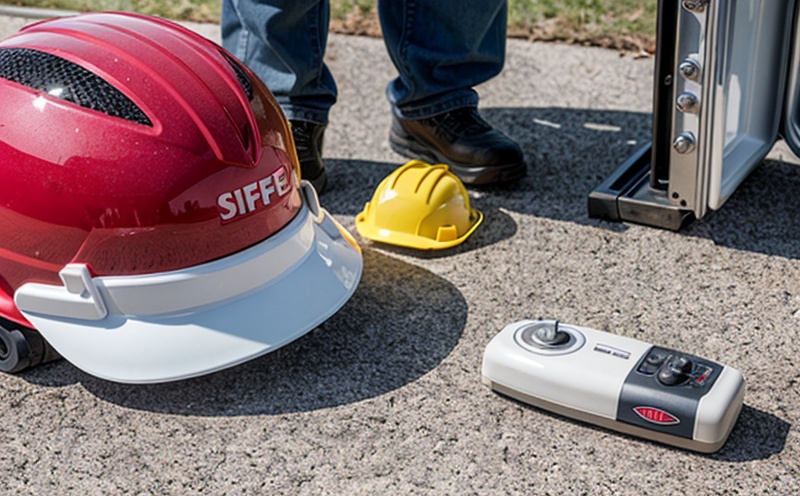ISO 18815 Lifeboat Release Gear Testing
The ISO 18815 standard provides comprehensive guidelines for the testing and certification of lifeboat release gear, which is a critical component in marine safety equipment. This standard ensures that lifeboats are reliably released under various conditions to ensure they can safely reach their designated location in an emergency scenario.
Lifeboat release gear is subject to rigorous testing due to its direct impact on human life and the environment. The test parameters outlined in ISO 18815 include static and dynamic load tests, immersion tests, operational tests under various environmental conditions, and fatigue testing. These tests are designed to evaluate the structural integrity, durability, and reliability of the release gear.
During the testing process, the specimen is prepared by simulating real-world usage scenarios, including different types of lifeboats and environmental factors such as temperature, humidity, and saltwater exposure. The instrumentation used for these tests includes load cells, pressure sensors, and video cameras to capture every aspect of the release gear's performance.
The testing process begins with a static load test to ensure that the release gear can withstand the maximum expected forces without failure. Following this, dynamic loading is applied to simulate real-world conditions. Immersion tests assess how well the gear performs in saltwater environments, which are corrosive and can affect metal components over time.
Operational testing ensures that the release gear functions correctly under various environmental conditions, including temperature extremes and humidity levels. This type of testing helps identify any potential issues with the gear's operation before it is deployed on a lifeboat. Fatigue testing simulates repeated use to ensure the gear can withstand numerous deployments without failing.
Once all tests have been completed, detailed reports are generated for each specimen tested. These reports provide comprehensive data on the performance of the release gear under various conditions. The results of these tests are crucial in ensuring that lifeboats are safe and reliable, which is essential for protecting lives at sea.
- Static Load Test
- Dynamic Load Test
- Immersion Test
- Operational Test
- Fatigue Test
The testing process ensures that lifeboat release gear meets the highest standards of safety and reliability. By adhering to ISO 18815, manufacturers can be confident that their products will perform under the most challenging conditions.
Regular testing is essential for maintaining the integrity and reliability of lifeboat release gear. This not only protects lives but also helps prevent potential environmental hazards associated with failed equipment. The results of these tests provide valuable insights into the performance of the gear, allowing manufacturers to make necessary improvements and updates as needed.
Why Choose This Test
Selecting ISO 18815 Lifeboat Release Gear Testing for your marine safety equipment is crucial due to its stringent requirements and comprehensive approach. This test ensures that the release gear meets the highest standards of performance, reliability, and durability.
- Comprehensive testing covers static and dynamic load tests
- Immersion tests ensure saltwater resistance
- Operational tests simulate real-world conditions
- Fatigue testing ensures long-term reliability
The test results provide valuable insights into the performance of the release gear, allowing manufacturers to make necessary improvements and updates. By adhering to ISO 18815, you can be confident that your products will perform under the most challenging conditions.
Regular testing is essential for maintaining the integrity and reliability of lifeboat release gear. This not only protects lives but also helps prevent potential environmental hazards associated with failed equipment. The results of these tests provide valuable insights into the performance of the gear, allowing manufacturers to make necessary improvements and updates as needed.
International Acceptance and Recognition
The ISO 18815 standard for lifeboat release gear testing is widely accepted and recognized by numerous international organizations and regulatory bodies. This includes:
- IMO (International Maritime Organization)
- ABS (American Bureau of Shipping)
- RINA (Registro Italiano Navale)
- Lloyd's Register
- DNV GL (Det Norske Veritas Germanischer Lloyd)
The standard has been adopted by these organizations due to its robust and comprehensive approach to testing lifeboat release gear. This ensures that the equipment meets the highest standards of safety, reliability, and durability.
The widespread acceptance and recognition of ISO 18815 make it a reliable choice for manufacturers looking to ensure their products meet international standards. By adhering to this standard, you can be confident that your lifeboat release gear will perform under the most challenging conditions.
Environmental and Sustainability Contributions
The testing of lifeboat release gear according to ISO 18815 plays a crucial role in environmental sustainability. By ensuring that the equipment meets stringent standards for performance, reliability, and durability, this process helps prevent accidents at sea that could lead to pollution or other environmental hazards.
Regular testing ensures that the equipment remains reliable over time, reducing the likelihood of failures during critical moments. This is particularly important in the marine industry, where accidents can have severe consequences for both human life and the environment.
The results of these tests provide valuable insights into the performance of the gear, allowing manufacturers to make necessary improvements and updates as needed. By adhering to ISO 18815, you can be confident that your products will perform under the most challenging conditions, contributing to a safer and more sustainable marine environment.





